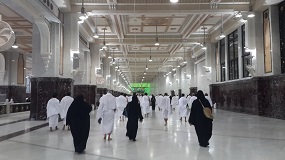Using AI to control energy for indoor agriculture
30 September 2024
Published online 21 July 2014
Air quality in holy sites of Saudi Arabia sharply deteriorates during the pilgrimage seasons, exposing pilgrims to dangerous gases.

© Mohammed Yahia/Nature Middle East
Several one-minute air samples were taken from Mecca and the central pilgrimage route, which extends to Mina, Arafat, and Muzdalifah, during the main Hajj season – the largest annual Muslim gathering in the world. Those samples revealed elevated CO levels of 57 parts per million by volume (ppmv) - exceeding the maximum average concentration deemed acceptable by the US Environmental Protection Agency (US EPA).
The study, a collaboration by a team from University of California at Irvine (UC Irvine) and King Abdulaziz University, started during the pilgrimage season in 2012 with a survey focusing on measuring carbon dioxide (CO2), methane (CH4), CO, and 96 speciated C1-C10 VOCs. It revealed that the major VOC sources came from vehicular exhaust and petrol evaporation.
Pilgrims spend a significant amount of time in major road tunnels, such as Souq al-Sagheer Azizia tunnels, during Hajj and the month of Ramadan, with traffic jams lasting up to an hour. The Souq al-Sagheer tunnel is particularly congested as it leads to the Grand Mosque.
Air samples from the tunnels turned out to be the most polluted, according to the survey. The Souq al-Sagheer tunnel had more than 1200 parts per billion by volume (ppbv) of gasoline evaporation tracer i-pentane. And the highest CO level (57,400 ppbv) ever recorded by the research group was measured in that tunnel. Likewise, a high benzene level of 185 ppbv was also recorded, exceeding the one-hour air quality standard of 9 ppbv.
Future studies are expected to expand the scope of sampling. “[Besides] measurements throughout the Mecca area, we hope to include more detailed surveys of tunnels in order to get a better idea of what pilgrims are breathing in these more highly concentrated areas,” says researcher Isobel Simpson from University of California at Irvine (UC Irvine). “Continued surveys would also help us understand how the air quality in Mecca is changing with time.”
Meanwhile, the Saudi Arabian government is already acting on the problem, according to a report in the Saudi-based Arab News. The Civil Defense spokesman, Saleh Al-Olyani, told the newspaper that they are working on improving ventilation and controlling carbon emissions from vehicle exhaust within tunnels.
“We would like to coordinate with groups that measure complementary air pollutants, such as nitrogen oxides, in order to get a more complete assessment of Mecca's air pollution. This in turn would allow us to better understand the formation of other harmful pollutants such as ground-level ozone,” adds Simpson.
Tahir Husain, a researcher from Memorial University of Newfoundland, who was not involved in the study, says that the research is a good start, but the researchers should have collected data on fine particulate matters as well. “Fine particulates, especially less than 2.5 microns, are very harmful to health and have a direct link to many respiratory and heart related issues.”
doi:10.1038/nmiddleeast.2014.190
Stay connected: